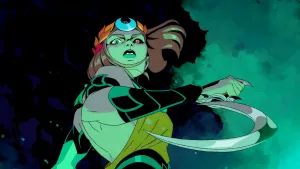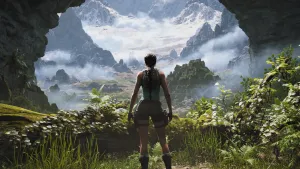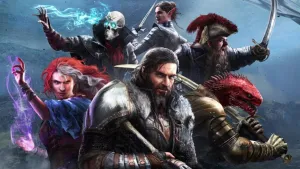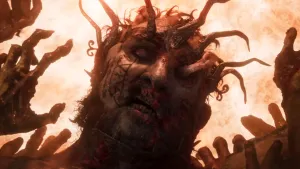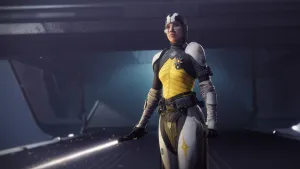Star Wars Loremasters: Keeper Of The Holocron

Leland Chee is the Continuity Database Administrator for LucasArts, which means he is in charge of keeping all of Star Wars’ fiction straight. As an extension to our Loremasters feature in the November issue we chat with Chee about his job and what it’s like being the keeper of the Holocron.
 Who’s in charge of keeping track of a game’s lore and history? How many people does it take? What are the daily duties like?
Who’s in charge of keeping track of a game’s lore and history? How many people does it take? What are the daily duties like?
The development teams track the game's internal lore and history. LucasArts sends the design docs, visuals, in-game text, and dialogue among other things to Lucas Licensing for approval. As the Continuity Database Administrator (ie "Keeper of the Holocron") for Lucas Licensing, I'm the person who looks at the material on the Licensing side for continuity- checking to make sure it fits within existing continuity and to also check to make sure that there are no conflicts with anything else currently in development, whether it be other games, television shows, novels, comics, or other merchandise. I also keep track of any new textual lore created by the game, which includes new characters, planets, technology, and species. We archive all visuals from new games in a separate database. The Holocron and the image database are linked so you can see visuals from the image database through the Holocron. At one point in LucasArts' history, LucasArts had its own dedicated Star Wars continuity supervisor but since everything would have to ultimately go to Licensing for approval, it was decided that the producers would coordinate with Licensing directly as well as have direct access to the Holocron database to manage continuity beyond the regular Licensing approval process.
What goes into making sure a property’s fiction stays accurate? Maps? Bibles? Wikis?
The Holocron is at the core of maintaining canon in the Star Wars universe. Its main function is to serve as an encyclopedia to track what has already been developed as well as what is currently in development. The Holocron is constantly updated, so as things change during development, the Holocron gets updated as well. We also use both published and internal reference including maps, organization charts, family trees, alien language translations, and timelines. Almost everything is stored electronically, so there is no need for printed bibles, which Licensing had previously used up until the Holocron was created in 2000. For video games, the producers on each game have direct access to the Holocron at the start of the development process. We have hundreds of reference books, novels, comics, scripts as well as other internal databases and reference for tracking things like images, film clips, and sound effects. Some game development teams create intranet wikis to maintain a game's internal continuity. Fan-generated resources like the Unofficial Star Wars Encyclopedia and the Star Wars wiki (dubbed Wookieepedia) are sometimes used by developers, but all this information has to be confirmed by an official source. For that, Licensing and LucasArts have libraries of all the Star Wars books that have ever been published, both domestic and international.
When you decide to add something new to the fiction what is that process like?
I try not to do any of the creation myself, so I can only speak to the approval process. Whether it's a character name or the look of a new species, the first thing we ask is does it feel like Star Wars? Is it too close to something earthly? Is it too close to something from another franchise? With a character name, we might consider whether it's too hard to pronounce or if something is good or evil sounding enough. Some names, like those for new Darth character s follow a certain naming convention, and we do what we can to try to have some sort of consistency with naming. If the new lore is tied to something that already exists, we do what we can to make sure it doesn't contradict anything else previously established.
How do you keep track of all the stuff that happens in the universe? How does it work when you have other companies, making books or comics or action figures and contributing their little bits to the story?
Everything being created whether it be for games, novels or television, is entered in to the Holocron database as a early as possible in the development process. In this way, creators can "stake their claim" on any new continuity that is in the process of being created. At the same time, we can immediately begin sharing this information internally. With Star Wars, we're always looking for tie-in opportunities in which stories can be adapted and or expanded upon beyond their original medium, which some people call "transmedia storytelling." An early example of transmedia was the Shadows of the Empire "multimedia event" that told of the events that take place between the The Empire Strikes Back and Return of the Jedi. In that story we learn things like how Luke got his second lightsaber, where Leia got the Boushh disguise she used to infiltrate Jabba the Hutt's Palace in Jedi, and the ordeal that Boba Fett had to go through to deliver the carbon-frozen Han Solo to Jabba. Different parts of the story were told through the Shadows of the Empire video game, the Shadows of the Empire novel, and the Shadows of the Empire comics. Other merchandised based on the story included action figures, collectibles, roleplaying games, and even a soundtrack CD. We recently took this same transmedia storytellingapproach to The Force Unleashed which spawned a #1 best-selling novel released prior to the video game. The Force Unleashed spawned action figures, a Lego set, a comic adaptation, a making of book, a roleplaying game book, figures for the Star Wars Miniatures game, among others. In order for these transmedia projects to work, we have to have systems in place to be able to confidently share resources between our various development partners, and the Holocron and image databases are important parts of these systems.
How do the duties of the lore keeper change throughout a development cycle? Or when you begin working on a new game/movie/show?
Ideally, we begin at the earliest stages. Before a design doc is even generated, writers or producers will sometimes check with me to see if there are any areas where potential continuity issues might arise with the game idea they have in mind. It is then that I might be asked something like whether anything in the existing lore fits a niche that needs to be filled in the game. The most common example of this is when a game needs a planet with a certain type of terrain, like say, a snow planet. I can look up all the snow planets in the Holocron and come up with a list of suggestions to offer the developers that I think might fit the parameters of the game. Later in the process, I will formally see game material when they send it in to Licensing for approval, often times in the form of a design doc. With books and comics, we'll usually see an outline when the story idea is first pitched. The movies and new television series are treated differently in that those stories do not come into Licensing for prior approval.
What do you do when contradictions arise in the fiction? Do you have any stories about when you had to resolve a contradiction?
With Star Wars, we attempt to come up with a plausible explanation for the existence of any such contradictions. Often times one source will only offer a single perspective of a story, but we can rationalize that the other stories add previously unseen perspectives to the original story. The stealing of the Death Star plans is an example in which each new story contributes a peace to a larger, expanding puzzle. What started off as a single line in the opening crawl of A New Hope, "Rebel spies managed to steal secret plans to the Empire's" has been covered in everything from the Star Wars radio drama, several video game including X-Wing, Dark Forces, and Battlefront II as well as numerous books.
Are you knowledgeable about actual history? Which is cooler?
As far as fictional continuity is concerned, the lesson I constantly take in from real-world history is that it is vastly complicated and continuously evolving. What we take as fact one day, may change the next. Who knew Pluto would stop being a planet? How long did the Hundred Years' War last? Were the Vietnam and Korean Wars really wars? So when we come upon things that appear to be contradictions in Star Wars, it's nice to know we're not alone.

Get the Game Informer Print Edition!
Explore your favorite games in premium print format, delivered to your door.
- 10 issues per year
- Only $4.80 per issue
- Full digital magazine archive access
- Since 1991


